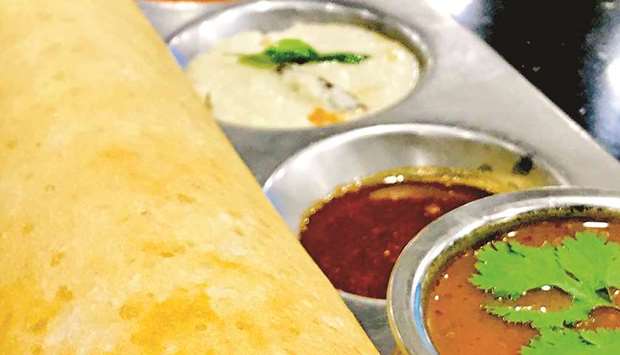I am sure almost everyone reading this article is familiar with what is dosa but may not be too comfortable to make this dish at home. I would like to make dosa-making simple and easy for all my readers.
India is a land of remarkable diversity, from diverse traditions, landscapes to culinary delights, varying significantly by region. In India, food plays a large part in the country’s culture. Traditionally south Indian crepe dosa is widely recognised across the country. It is relished for its unique flavour, seasoning, taste, visual appeal and fragrance. Known by different names like dosai, dosa, dosay, it is a breakfast dish but is equally popular in lunch and dinner or simply as a snack. Dosa was recently named as the 50 most delicious dishes by CNN. Dosa is undoubtedly one the most ancient dishes, dating back to the 5th century AD. Originally Dosa were made from lentils but slowly the rice was added to make the dish in its present form which is liked by all. Dosa is traditionally served with accompaniments like sambhar, a thin lentil stew, coconut chutney and tomato chutney and spiced lentil powder called podi powder.
People prefer different variations and styles of dosa, some prefer it like a thick pancake while some like it crispy and thin. I prefer the thin and crispier version. Dosa is considered a healthy food due to no sugar, very little fat content and being rich in carbohydrates and is easy to digest. A portion of dosa contains around 100 calories which is way less than a cheese pizza or a cheese burger. There are hundreds of varieties of dosa and the numbers are still growing with more chefs experimenting with it and trying to make their signature style out of the traditional recipe. Some of the Michelin starred restaurants even have dosa as a regular in their menu.
Surprisingly, Uthappam, an almost similar dish existed before the dosa around 1st century AD and is basically the same batter, except being thicker, fluffier and usually topped with spices, onion, curry leaves and chilies, and is cooked from both sides. Making thin dosa on a flat griddle requires some skills but initially one can practice making a thicker version which is easy to make and tastes equally good.
Over the course of all those centuries, the simple dosa recipe has travelled far and wide, first within the southern states of India — Kerala, Karnataka, Andhra Pradesh and Tamil Nadu — then within India and soon after, across the globe. Dosa is not only popular in India but in countries like Sri lanka, Mauritius, Singapore, Malaysia, Nepal, Bangladesh, Myanmar to name a few.
Popular variations today include paper dosa, which is crispy and thin like a paper; multigrain dosa, a fancier and newer dosa; masala dosa, filled with a delicious potato bhaji; Mysore dosa, whose namesake invokes images of a fiery red chutney-laden dosa; rava dosa, made from semolina instead of rice; the cheese, paneer cottage cheese and many more.
“The key to the perfect dosa, apart from getting the batter’s consistency right, of course, is the temperature of the griddle, the more you practice making it, the better is the result and you’ll get better day by day. Making a dosa batter requires a special short rice called poni rice, idli rice, parboiled rice or sona masori.
One most important and frequently asked question about making dosa batter is “when to add salt” before grinding, after grinding, before fermentation or after fermentation? The ideal time to add the salt is after the fermentation so the salt does not affect the fermentation process and you can accurately taste and measure the salt in the finished batter. The Urad wash lentil and rice is soaked for about 2-3 hours and then grounded separately. The dal should be smooth and the rice to be little coarser than the lentil. Then combine both and leave it in a covered container in a warm spot in your kitchen. Next day morning add salt and mix the batter to combine well and removed excess air from fermentation. Store in air tight containers and use as required. The ratio of lentil and rice is 1:3.
Dosa Batter Recipe
Ingredients
Parboiled rice 3 cups
Urad wash lentil 1 cup
Fenugreek seeds ½ tsp
Salt to taste
For potato masala
Boiled potato 200 gm
Oil ½ cup
Mustard seeds 1 tbsp
Asafetida 1 tsp
Red chilly whole 4-6 nos
Curry leaves 3-4 sprigs
Ginger chopped 1 tbsp
Green chili chopped 1 tbsp
Onion, sliced 2 nos.
Salt to taste
Turmeric powder 1 tsp
Garam masala 1 tsp
Red chili powder 1 tsp
Cilantro chopped ½ cup
Method:
Wash and soak the parboil rice and urad lentil separately for about 2-3 hours.
In a wet masala grinder, grind the urad dal to a smooth paste, add some water if required.
Remove the urad dal paste and grind the parboil rice and fenugreek seeds in the masala grinder and grind to a slightly coarser texture than the lentil mixture.
Combine both the mixtures and keep aside covered overnight in a warm place in kitchen, the batter will rise to more than double the initial batter volume.
Add salt and mix the batter using a whisk to remove excess air, store in air tight container in refrigerator for 3-4 days.
For the potato masala mixture
Mash the peeled and boiled potato in a bowl.
In a heavy bottom pan heat oil, add mustard seeds to crackle.
Add asafetida, ginger chopped, green chilly chopped, red chili whole, sliced onions and stir.
Add the red chili powder, garam masala and salt.
Once the onions become translucent add the prepared tempering to the boiled potato add cilantro and combine well.
Adjust the seasoning and keep aside.
To make the dosa, heat a nonstick flat top and drizzle some oil over medium heat.
Add ½ cup of dosa batter and spread using the base of the bowl.
Drizzle some oil to make the dosa crispy.
Place the warm potato filling on one side and roll the dosa batter to make a roll and serve hot.

RECOGNITION: Dosa was recently named among the 50 most delicious dishes by CNN.


